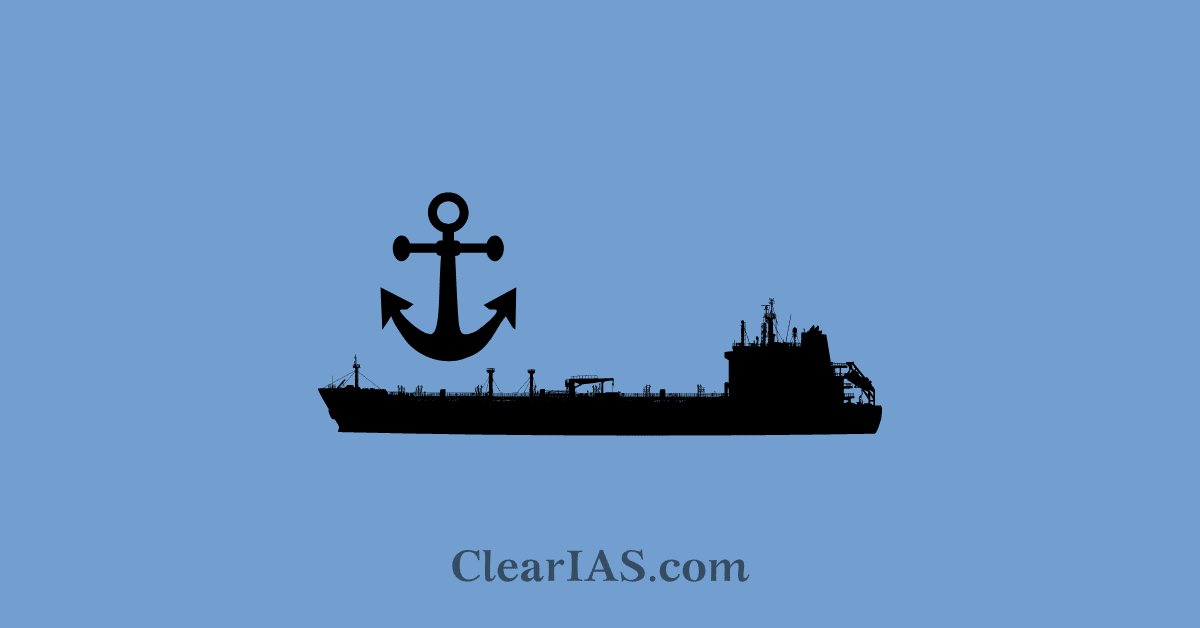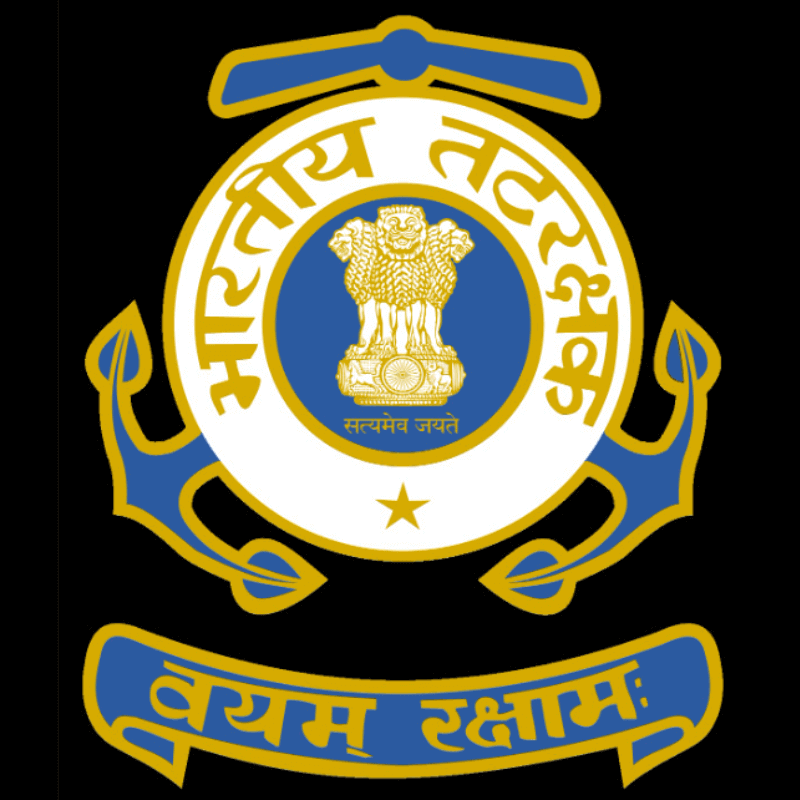
The Indian Coast Guard is India’s maritime law enforcement force. Read here to know more about the Indian Coast Guard.
The Indian Coast Guard (ICG) is the maritime law enforcement and search and rescue agency of India with jurisdiction over its territorial waters including its contiguous zone and exclusive economic zone.
The Indian Coast Guard is a multi-mission organization, conducting round-the-year real-life operations at sea. Despite being relatively small, it has a wide range of task capabilities for both surface and air operations.
The Coast Guard works in close cooperation with the Indian Navy, the Department of Fisheries, the Department of Revenue (Customs), and the Central and State police forces.
Their motto is “Vayam Raksamah” which means “We protect”. The Coast Guard day is observed on February 1.

History of Indian Coast Guard
The Indian Coast Guard was formally established on 1 February 1977 by the Coast Guard Act, 1978 of the Parliament of India. It operates under the Ministry of Defence.
The coast guard force was proposed by the Indian Navy in the 1960s when the sea-borne smuggling of goods was increasingly threatening the Indian economy.
The Nagchaudhuri Committee was constituted with participation from the Indian Navy and the Indian Air Force to study the problem. In August 1971, the committee identified the requirement to patrol India’s vast coastline.
By 1973, India had started a program to acquire the equipment and started deputing personnel from the Indian Navy for these anti-smuggling and law enforcement tasks.
In 1972, the United Nations Convention on the Laws of the Sea (UNCLOS) awarded Exclusive Economic Zones (EEZ) to all coastal states. Thereafter the Union of India, enacted the Maritime Zones of India Act 1976 to claim sovereign rights over the vast sea area of the Exclusive Economic Zone.
In one stroke, India acquired 2.01 million sq km of the ocean for extensive exploitation of all living and non-living resources, and this vast area needed to be policed.
The discovery of oil in Mumbai (then Bombay) High, and the consequent development of high-value offshore installations, also necessitated measures for protection and disaster response in this extremely vital area of India’s industrial and economic interests.
In 1977, Union Cabinet approved the setting up of a Coast Guard’ with two frigates and five patrol boats transferred from the Indian Navy.
The duties and functions of the service were formally defined in the Coast Guard Act, which was passed by India’s parliament on 18 August 1978 and came into immediate effect.
The first Indian Coast Guard Ship ICGS Kuthar was transferred from the Indian Navy to the Indian Coast Guard in 1978.
The Indian Coast Guard inducted Chetak helicopters in 1982 as the standard Search and Rescue helicopter due to their vastly proven safety record. The helicopter is being manufactured in India by HAL since 1965.
Organization of Indian Coast Guard
The organization is headed by the Director-General of Indian Coast Guard (DGICG) exercising his overall command and superintendence from the Coast Guard Headquarters (CGHQ) located in New Delhi.
At CGHQ, he is assisted by four Deputy Director Generals of the rank of Inspector General, and other senior officers heading various staff divisions.
For effective command and control, the Maritime Zones of India are divided into five Coast Guard Regions, namely:
- North-West ( Regional Headquarters in Gandhinagar)
- West (Regional Headquarters at Mumbai)
- East (Regional Headquarters at Chennai)
- North-East (Regional Headquarters at Kolkata)
- Andaman & Nicobar (Regional Headquarters at Port Blair)
The Coast Guard Regions are commanded by Officers of the rank of Inspector General.
The regions are further divided into twelve Coast Guard ‘Districts’, one each for the nine coastal states on the mainland, two in the Andaman & Nicobar Region, and one at Kavaratti in the Lakshadweep and Minicoy Islands.
Each Coast Guard District comprises one or more Coast Guard Stations. In addition, there are Coast Guard Air Stations (CGAS) and Air Enclaves (CGAE) for air operations from various locations along the coastline.
Missions of the ICG
- Safety and protection of artificial islands, offshore terminals, and other installations
- Protection and assistance to fishermen and mariners at sea
- Preservation and protection of marine ecology and environment including pollution control
- Assistance to the Department of Customs and other authorities in anti-smuggling operations
- Law enforcement in territorial as well as international waters
- Scientific data collection and support
- National defence during hostilities (under the operational control of the Indian Navy)
Additional responsibilities of the Indian Coast Guard
- Offshore Security Coordination Committee (OSCC)
- National Maritime Search and Rescue Coordinating Authority (NMSARCA
- Lead Intelligence Agency (LIA) – For coastal and sea borders
- Coastal Security – The Director-General of the Indian Coast Guard is the commander of coastal command and is responsible for overall coordination between central and state agencies in all matters relating to coastal security.
Indian coast guard units
Offshore patrol vessels
Vikram class:
- Vigraha
- Vikram
- Vijaya
Samarth class
- Samarth
- Shoor
- Sarathi
- Shaunak
- Shaurya
- Sujay
Samar class
- Samar
- Sangram
- Sarang
- Sagar
Sankalp class
- Sankalp
- Samrat
Vishwast class
- Vishwast
- Vijit
- Vaibhav
Pollution control vessels
- Samudra prahari
- Samudra paheredar
- Samudra pavak
Fast patrol vessels
Priyadarshini class
- Razia sultana
Sarojini Naidu class
- Sarojini Naidu
- Subhadra kumari chauhan
- Durgabai Deshmukh
- Meera Behn
- Kasturba Gandhi
- Savitri Bai Phule
- Aruna Asaf Ali
Rani abbakka class
- Rani abbakka
- Rani avantibai
- Rani durgavati
- Rani gaidinliu
- Rani roshmoni
Rajshree class
- Rajshree
- Rajratan
- Rajtarang
- Rajdoot
- Rajkiran
- Rajveer
- Rajkamal
- Rajdhwaj
Aadesh class
- Aadesh
- Achook
- Ameya
- Anmol
- Abheek
- Agrim
- Amogh
- Apoorva
- Abhinav
- Amal
- Anagh
- Arinjay
- Abhiraj
- Amartya
- Ankit
- Arnvesh
- Arush
- Aryaman
- Atulya
- Ayush
Aircraft
- Dornier 228
- HAL Dhruv
- HAL Chetak
Recent developments
Pay Roll Automation for Disbursement of Monthly Allowances (PADMA), an automated Pay & Allowances module for the Indian Coast Guard was launched recently.
- PADMA is an automated platform leveraging the latest technology that will provide seamless and timely disbursal of Pay & Allowances to around 15,000 Indian Coast Guard personnel.





Leave a Reply